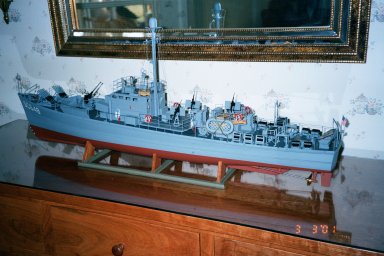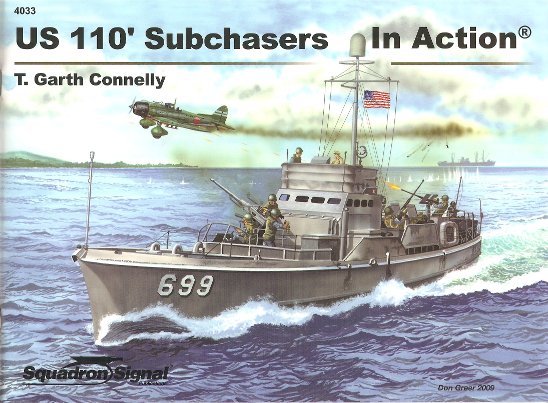Building a Model Subchaser
First, let’s examine some history about subchasers.
In the ship modeling community a naïve, romantic notion has evolved over the years. Many modelers have been led to believe that subchasers were pretty much the same in both world wars, (“a subchaser is a subchaser—if you’ve seen one you’ve seen ‘em all.”) One obvious reason for this myth has been the easy availability of only one complete kit, the Glencoe kit, for a World War I subchaser. There has never been a similar kit for WWII subchasers. This, despite the fact that the two wars, and the subchasers themselves, and the roles played by each, in those two wars, were radically different.
In World War I the U.S. navy didn’t participate in a single naval engagement. Nor were any U.S. ships attacked by air. In only one incident in WWI did subchasers have their “fifteen minutes in the sun.” This was when a dozen SCs formed the “Otranto Barrage”—a relatively simple, non-combat operation intended to prevent U boats from leaving the Adriatic. Their only “excitement” was at Durazzo when they entertained themselves shooting up enemy mines. They did not participate in nor see any combat..
The opposite is true with World War II subchasers. Those subchasers saw enough action to last a lifetime. The amphibious assaults, the constant air attacks, the strafing, the mortar fire, the kamikazes and other distractions, made enemy submarines the least of their worries. Hundreds of subchasers were in harm’s way during the war. They suffered numerous casualties. Too many subchasers were lost. Too many subchasers were critically wounded. Too many subchaser sailors never returned home.
For many years after the war if you wanted to make a model of a World War II subchaser you had to build the hull from scratch. But Microglass now offers a WWII molded bare hull with plans. The hull is a lightweight laminate of hand laid fiberglass mat and marine-grade resin finished in a smooth gellcoat. Length: 41-¼", Beam: 7", Scale: 1:32.
Microglass 2960 Pearce Road North Tonawanda, NY 14120 716-731-9717 www.microglass.net
Few commercial model kits for subchasers of either vintage are currently available, but occasionally they do appear on E-Bay. Some are really crude antique kits with wooden hulls (especially for WW I vessels), some are plastic, and some are resins. Line drawings are also available for the scratch (or the semi-scratch) builder.
Scratch scale drawings for WWII type SC hulls can be purchased from at least two suppliers:
The Floating Drydock P.O. Box 9587 Treasure Island, FL 33740 Fax: (727) 363-8198 floatingdrydock.com
Taubman Plans Service International 7527 Gilbert Road Bergen, NY 14416 Telephone: (585) 494-0027, Fax: (585) 494-1369 www.taubmansonline.com
For fittings, guns, ordnance and general supplies several sources are available:
- HR Products, Inc., PO Box 67, McHenry, IL 60051 Tel. 815-477-4636
- Scale Shipyard, 5866 Orange Ave #3, Long Beach, CA 90805-4146
- Dromedary Ship Modelers, 6324 Belton Drive, El Paso, TX 79912 Tel. 915-584-2445
- Bluejacket Shipcrafters, 160 E Main St, Searsport, ME 04974 Tel. 800-448-5567
- Model Expo Inc., 3850 N. 29th Terrace, Hollywood, FL 33022 Tel. 800-222-3876
- SteelNavy
If you have just been toying with the idea of building a model, there are several good magazines that can get you started with some ideas. These contain ads for all kinds of interesting sources for model makers. Scale drawings, authentic navy plans, scale kits, molded hulls, deck fittings, guns, ordnance, and books galore are all readily available, although specific information about WWII subchasers is skimpy.
You would need photographs - lots of them. The best source for detailed photos of subchasers would be National Archives, 8601 Adelphi Road, College Park, MD 20740-6001. The Naval Historical Center, Washington Navy Yard, Washington DC 20734-5060 has a large collection of photographs also. A third source is the Photo Archives of the United States Naval Institute, 291 Wood Rd, Annapolis MD 21402. Telephone: (410) 268-6110; Fax: (410) 269-7940.
A great source for modelers seeking—and sharing—maritime information is the Ship Modelers Mailing List (SMML) based in Australia and having an active Internet subscriber list of about 1200 people who are interested in just about anything related to all kinds of ships, whether real or model. SMML issues a free Internet journal daily, consisting of questions, answers, suggestions, experiences, leads, information, etc. as submitted by the international membership. There are no fees whatsoever. To enroll, simply e-mail to and ask to have your name and e-mail address added to the List. It is not necessary to be a modeler to participate, as historians and commentators etc. are welcome. Modelers range from absolute beginners to highly experienced professional builders of exquisite models of world-wide fame, but all communicate freely, in most general terms or in the finest detail, whichever is appropriate. This unique global website is indeed unusually helpful, informative, and interesting.
A scattered few craftsmen have built beautiful subchasers of museum quality. One of these is in the U.S. Naval Academy Museum in Annapolis. Two fine models are exhibited at the PCSA Collection located in the Historical Museum of Bay County in Bay City, Michigan (the “Birthplace of the PC”). Franklyn K. Brown, a modeler, is an enthusiastic aficionado of WWI subchasers and has a wealth of helpful information for anyone wishing to build a subchaser model. He can steer you to several sources and individuals and welcomes inquiries by email: .
There is now a 1:35 scale model of SC 201 at the Lyceum in Alexandria VA, built by Bernard Kempinski for the museum's WWI exhibition, on display through November 11, 2019.

Fine Art Model of SC 648 now on permanent display at the Navy Museum, Washington Navy Yard, Washington D.C.
If you have neither the time, ability or inclination to build a model subchaser but you would like to own one there is a great outfit that will make one for you. Fine Art Models, P.O. Box 225, Birmingham, MI 48012, Telephone: (248) 288-5155 produces exquisite, museum-quality, limited-edition scale models as fine as any you’ve ever seen. Their models can be found in museums and private collections around the world. They have reproduced a subchaser in a 3/8":1' model measuring slightly more than 41 inches in length. The hull is made from high-definition resin, the wood that shows is real wood and everything above the deck is hand-fabricated brass. The interior of the pilot house is finished off. The mousetrap rails can be raised and lowered. The model comes mounted on a shipping cradle complete with walnut display base and plexi-glass cover. It is not inexpensive and the delivery time is lengthy - but isn’t this true of all worthwhile things?
Paper models and miniatures
Another way to make a subchaser model is with paper cardstock. Paper-Lab sells a CD with plans for a 13.4 cm (5-¼") subchaser model that can be printed and assembled.
Iron Shipwright sells a 1/350 resin miniature of a WWII SC. There is a review by Ed Grune.
The P.T. Dockyard sells 1/600 miniatures in resin of naval ships, including subchasers.
Engert Ship Models sells all types of ship models from all nations in a 1:1250 scale. A US SC-class subchaser is available for €5.50 (about USD $8.71)

A new 64-page booklet titled US 110’ Subchasers in Action has just been written by T. Garth Connelly that can be of help to anyone wanting to build either type of subchaser. It contains numerous details and photographs, including plan and elevation drawings, of SCs of both generations. It further provides information about the placement of fittings and ordnance, plus painting suggestions. The booklet is published by Squadron Signal Publications.